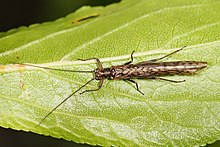(1) Another big stonefly, bigger than an American Cockroach and with a completely different look in real life, was resting between Route 58 and the quarry pond in Gate City on Wednesday morning. Stoneflies are large to extra-large, not at all pretty insects. A few years ago I photographed one and posted on Bubblews that I didn't know what it was; someone thought the blurry cell phone image looked like a roach. The insect really doesn't; no wing cases, different head shape, thicker neck, different type of antennae.
This is an exotic species (from Australia), photographed by Fir0002/Flagstaffotos for Wikipedia, showing the totally un-roach-like body shape. The two stoneflies I've seen had even more transparent wings than the speckly wings shown below, but had the same bolt-shaped body. Images of a wingless juvenile stonefly, and a mating pair, of two other species appear along with this image at https://en.wikipedia.org/wiki/Plecoptera .

Stoneflies look as if they might be trouble, so it's pleasant to read that they are not. They're actually good news since they can only live in clean water. They help keep the water clean by eating rotting leaves.
(2) Now here's the pretty one...This luna moth was photographed by Megan McCarty for Wikipedia, a great source of free pictures:

This and more luna moth images, including a super-close-up, magnified image of the tiny hairs that form the color pattern of a moth's wing, are at https://en.wikipedia.org/wiki/Actias_luna .
On the way out this morning I saw a young, freshly killed female luna moth under a persimmon tree beside the road. Three wings were attached to the body; the fourth wing, torn in two, was nearby. The abdominal segment of the moth had been neatly removed by a bright and early bird. The wings showed no wear. All the big silk moths wear out quickly; I wondered whether Ms. Luna had at least had a chance to fly during the night, or been caught just after emerging from the cocoon.
Then, about 200 yards further along the road, I saw one more fresh wing from a different luna moth. Ms. Luna's mate? Did they ever get a chance to mate?
Ah, well...these moths are actually common, although they tend to spread out through the woods, and sparse populations plus short life spans keep them a fairly rare sight. I don't see one every single summer; that doesn't mean they're not flying in the woods. They are. They're just good, remarkably good considering what big showy moths they are, at keeping out of sight.
(3) Further observations: Weather--typical early August weather. Daytime highs in the eighties when cloudy, nineties when sunny. Humidity also in the eighties and nineties. Rain in unpredictable "showers" at all hours of day and night, having very little effect on the heat and humidity. Can't wait for it to end.
Flowers: more cultivated flowers than wild ones visible. Chicory abundant. Queen Anne's Lace. Queen of the Meadow.
Birds: Quite a few visitors seem to be flying and singing around the Cat Sanctuary. Of course, it's hard to see them in the treetops, and since there's at least one mockingbird family in the neighborhood it's impossible to identify them by their calls. The cardinal says "Cheer! Cheer! Cheer!" but so does the mockingbird, whose nest is about a mile closer to town.
What's noteworthy is that bird populations have climbed to the point where I'm hearing songbirds around the Cat Sanctuary, in August, with any frequency. Songbirds pass through, singing their heads off, between January and June, and in recent spring nesting seasons the woodlot has become quite noisy. In July and August most songbirds quieten down and rest, growing fresh feathers and putting on weight before moving south for the winter; most of the time, most individual birds have settled down within their territories and don't have so much to say to their neighbors. So I know that, despite the free-range cats, songbird population density is increasing steadily as the woods recover from what really caused bird populations to plummet in the late twentieth century--North America's infatuation with poison sprays.
[Update: When +LadyNightwaveBrendaMarie Writer shared this on Google +, a quirk in Google's software caused it to show up with the wrong picture. I wondered whether Google + was scolding me for not throwing in the Obligatory Amazon Link an Amazon Affiliate blog should have. Turns out it wasn't, but here's a classic book link...I enjoyed this book as a child and so, if you can afford it, will you or your child.]

No comments:
Post a Comment